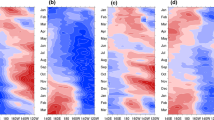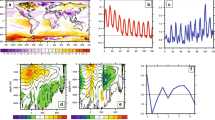Summary
Using large-scale circulation statistics from the Pacific Ocean basin, predictability of the coupled ocean-atmosphere system on interannual time scales is found both to be limited in extent and to possess a strong annual cycle. Irrespective of when lagged correlations are commenced, correlations decrease rapidly through the boreal spring, indicating an inherent predictability limitation for large scale coupled oceanicatmospheric processes such as El Niño. Long term prediction experiments using numerical coupled-models show that the models are excellent facsimiles of the real system. They, too, encounter the predictability barrier and exhibit a substantial decrease in observation-prediction correlation across the boreal spring. Thus, a predictive system based solely on the interactive physics of the Pacific Basin appears limited to a maximum of less than one year and a minimum of only one or two months.
Two hypotheses are made to explain the existence of the predictability barrier. First, it is argued that the tropical coupled system is at its frailest state during the boreal spring and that the signal-to-noise ratio is weakest. In such a system, maximum random error growth may occur as the atmosphere and the ocean become temporally detached and wander onto different climate trajectories. A series of 144 preliminary Monte Carlo experiments were conducted with a coupled ocean-atmosphere model to test the hypothesis. Irrespective of when the experiments were commenced, error growth was maximized at the same time of the year. The second hypothesis suggests that the near-equatorial circulation is perturbed at the time of its weakest state by external influences such as the monsoon and that the climate wanderings are “nudged” deterministically. There is observational and theoretical evidence to support the hypothesis. Observations suggest that anomalous monsoons impart basin-wide coherent alterations of the wind stress field in the Pacific Ocean. Experiments with a coupled ocean-atmosphere model show that the period of an ENSO event is altered substantially by an anomalous monsoon. Given that there appear to be precursors to anomalous monsoons, it is suggested that there may be ways to avoid the predictability barrier and thus extend prediction of the entire system.
Finally, noting that the two hypotheses are not mutually exclusive, they are combined to form a unified theory. As the asymmetric monsoonal and the symmetric near-equatorial heating are in approximate quadrature, it is argued that the monsoons influence the Walker circulation during the boreal spring. However, during the boreal fall and early winter the near-equatorial heating variability dominates the winter monsoon.
Similar content being viewed by others
References
Anderson, D., McCreary, J., 1985: Slowly moving disturbances in a coupled ocean-atmosphere model.J. Atmos. Sci.,42, 615–629.
Battisti, D. S., Hirst, A. C., 1989: Interannual variability in a tropical atmosphere-ocean model: Influence of the basic state, ocean geometry and nonlinearity.J. Atmos. Sci. 46, 1687–1712.
Bjerknes, J. 1969: Atmospheric teleconnections from the equatorial Pacific.Mon. Wea. Rev. 97, 163–172.
Cane, M. A., 1991: Forecasting El Niño with a geophysical model, Chapter 11. In: Glantz, M., Katz, R., Nicholls, N., (eds.)Teleconnections Connecting World-Wide Climate Anomalies, Cambridge: Cambridge University Press, 345–369.
Cane, M. A., Zebiak, S. E., 1985: A theory of El Niño and the southern oscillation.Science,228, 1085–1087.
Dixit, S., 1993: The role of the mean atmospheric flow in interannual predictability, PhD Thesis, The Department of Meteorology, The Pennsylvania State University, 245 pp.
Dixit, S., Webster, P. J., 1992: The role of the mean flow in low-frequency variations in the Pacific Ocean. Proceedings of the Climate Diagnostics Workshop, October, Norman, Oklahoma.
Gill, A. E., 1980: Some simple solutions for heat induced tropical circulations.Quart. J. Roy. Meteor. Soc.,106, 447–462.
Hao, Z., Neelin, J. D., Jin, F.-F., 1993: Nonlinear tropical air-sea interaction in the fast-wave limit.J. Climatol.,6, 1523–1544.
Latif, M., Graham, N. E., 1991: How much predictive skill is contained in the thermal structure of an OGCM?TOGA Notes,2, 6–8.
Neelin, J. D., 1991: The slow sea surface temperature mode and the fast-wave limit: Analytic theory for tropical interannual oscillations and experiments in a hybrid coupled model.J. Atmos. Sci.,48, 584–6065.
Neelin, J. D., Jin, F.-F., 1993: Modes of interannual tropical ocean-atmosphere interaction. —A unified view: Part II. Analytic results in the weak coupling limit.J. Atmos. Sci.,50, (in press).
Nicholls, N. N., 1984: The southern oscillation and Indonesian sea surface temperature.Mon Wea. Rev.,112, 424–432.
Normand, C., 1953: Monsoon seasonal forecasting.Quart. J. Roy. Meteor. Soc.,79, 463–473.
Philander, S. G., 1990:El Niño and the Southern Oscillation. San Diego: Academic Press, 289 pp. (International Geophysics Series,46).
Rasmusson, E. M., Carpenter, Y. H., 1983: The relationship between the eastern Pacific sea surface temperature and rainfall over India and Sri Lanka.Mon. Wea. Rev.,111, 354–384.
Rasmusson, E. M., Wang, X., Ropelewski, C. F., 1990: The biennial component of ENSO variability.J. Marine Systems 1, 71–96.
Shukla, J., 1987a: Interannual variability of monsoon. In: Fein, J. S., Stephens, P. L. (eds.)Monsoons, Toronto: Wiley, 399–464.
Shukla, J., 1987b: Long-range forecasting of monsoons. In: Fein, J. S., Stephens, P. L. (eds.)Monsoons, Toronto: Wiley, 523–548.
Trenberth, K., 1984: Signal versus noise in the southern oscillation.Mon. Wea. Rev. 112, 326–332.
Troup, A. J. 1965: The southern oscillation.Quart. J. Roy. Meteor. Soc. 91, 490–506.
Vernekar, A. D., Zhou, J. Shukla, J., 1994: The effect of Eurasian snow cover on the Indian monsoon.J. Climatol. (submitted).
Wainer, I., Webster, P. J., 1993: Monsoon-ENSO relationships in a coupled ocean-atmosphere model.Quart. J. Roy. Meteor. Soc. (submitted).
Walker, G. T., 1923: Correlation in seasonal variations of weather III: A preliminary study of world weather.Mem. Indian Meteor. Dept.,24, 75–131.
Walker, G. T., 1924: Correlation in seasonal variations in weather. IV: A further study of world weather.Mem. Indian Meteor. Dept.,24, 275–332.
WCRP: World Meteorological Research Program, 1986: Scientific Plan for the Tropical Ocean Global Atmosphere Programme, WCRP Pub. #3, World Meteorological Organization, Geneva, 146 pp.
Webster, P. J., 1972: The response of the tropical atmosphere to local study forcing.Mon. Wea. Rev. 100, 518–541.
Webster, P. J., 1983: Mechanisms of monsoon low-frequency variability: Surface hydrological effects.J. Atmos. Sci. 49, 2110–2124.
Webster, P. J., 1994: The role of hydrological processes in ocean-atmosphere interaction.Rev. Geophys. (to appear).
Webster, P. J., Chou, L. 1982: Low frequency transitions of a simple monsoon system.J. Atmos. Sci.,37, 368–382.
Webster, P. J., Yang, S., 1992: Monsoon and ENSO: Selectively interactive systems.Quart. J. Roy. Meteor. Soc. 118, 877–926.
Webster, P. J., Chou, L., 1982: Low frequency transitions of cycle of the coupled ocean-atmosphere system of the Indian Ocean.Quart. J. Roy. Meteor. Soc. (submitted).
Yasunari, T., 1987: Global structure of the El Niño/Southern oscillation. Part II. Time evolution.J. Meteor. Soc. Japan,65, 81–102.
Yasunari, T. 1991: The monsoon year—a new concept of the climate year in the tropics.Bull. Amer. Meteor. Soc.,72, 1331–1338.
Zebiak, S. E., Cane, M. A., 1987: A model El Niño-Southern oscillation.Mon. Wea. Rev.,115, 2262–2278.
Author information
Authors and Affiliations
Additional information
With 18 Figures
Rights and permissions
About this article
Cite this article
Webster, P.J. The annual cycle and the predictability of the tropical coupled ocean-atmosphere system. Meteorl. Atmos. Phys. 56, 33–55 (1995). https://doi.org/10.1007/BF01022520
Received:
Issue Date:
DOI: https://doi.org/10.1007/BF01022520




